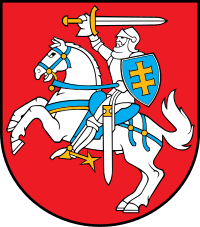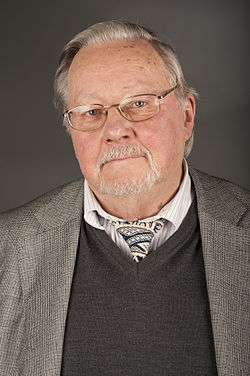Lithuanian parliamentary election, 1996
| | ||||||||||||||||||||||||||||||||||||||
| ||||||||||||||||||||||||||||||||||||||
| ||||||||||||||||||||||||||||||||||||||
| ||||||||||||||||||||||||||||||||||||||
 |
| This article is part of a series on the politics and government of Lithuania |
| Constitution |
|
Legislature |
|
Judiciary |
|
Parliamentary elections were held in Lithuania in two stages on 20 October and 10 November 1996.[1] All 141 seats in the Seimas were up for election; 70 based on proportional party lists and 71 in single member constituencies. Where no candidate gained more than 50% of the vote on 20 October, a run-off was held on 10 November.
The first round of the elections was held concurrently with a referendum to amend Articles 55, 57 and 131 of the constitution, and a referendum on the use of proceeds from privatization. The second round was held concurrently with a referendum to amend Article 47 of the constitution. Due to a low turnout, none of the referendum questions succeeded in getting approval from at least 50% of registered voters.
Elections were won by the Homeland Union - Lithuanian Conservatives, which gained 70 seats, forming a coalition with second-place Lithuanian Christian Democratic Party. Homeland Union benefited from popular dissatisfaction with the ruling Democratic Labour Party of Lithuania, which had failed to reignite the economy and was plagued by financial scandals. Gediminas Vagnorius was subsequently appointed as the Prime Minister.
Electoral system
In his decree on 9 April 1996, the President of Lithuania Algirdas Brazauskas set the date of the elections to the Seimas for 20 October.[2] Elections took place under a mixed electoral system, with 70 MPs elected on proportional party lists and 71 MPs in single member constituencies. Run-off elections were to be held on 10 November in constituencies where no candidate received at least 50% of the votes cast.
In 1996 the threshold for a party to gain any of the 70 seats allocated proportionally was increased from 4% to 5% and a new threshold of 7% was introduced for electoral coalitions. The exception for electoral lists of national minorities was eliminated. The combined purpose of the changes was to reduce the number of small parties in the parliament. Elections in 1996 were also the first to allow the voters to give preference votes to candidates on electoral lists, although their influence was limited.[3]
Campaign
The main contestants in the elections were the ruling Democratic Labour Party of Lithuania (LDDP) and the Homeland Union - Lithuanian Conservatives. LDDP, led by Česlovas Juršėnas), had evolved from the Communist Party of Lithuania and handily won the previous elections to the Seimas. Homeland Union, led by Vytautas Landsbergis, was founded in 1993 from elements of Sąjūdis, a reform movement that had led the drive for independence from the Soviet Union.
Pre-election polls suggested a victory for the right-wing opposition over LDDP. The ruling party was suffering as a result of continued economic woes that were at the forefront of the debate: the economic situation was not improving as quickly as people expected. Financial scandals, including one involving former Prime Minister Adolfas Šleževičius also played a major role. Opposition, on the other hand, promised improvement and stability on the domestic scene and a fight against corruption.[2] Homeland Union secured the support of major business leaders before the election: in October 1996 Gediminas Vagnorius and Bronislovas Lubys, the leader of Lithuanian Confederation of Industrialists signed a memorandum, creating an alliance of politics and industry. Homeland Union also received support and financial contributions from international companies and Lithuanian diaspora.[3] All major parties generally agreed on foreign policy goals of affiliation with NATO and European institutions).
Altogether 1351 candidates, representing 28 political parties, vied for the 141 seats at stake. 24 political parties competed for the proportionally allocated seats.[3]
Results
In the elections characterized by a substantially lower turnout than before, Homeland Union gained 70 seats.[2] Lithuanian Christian Democratic Party finished as a distant runner-up with 16 seats. The ruling LDDP won only 12 seats, compared to 73 in the previous elections.
The votes in the election were more dispersed than before. This, together with the changes to the electoral law increasing the threshold for nationwide constituency had the effect of increasing the wasted votes in the constituency from 14% in elections of 1992 to 32% in 1996.
| Party | Proportional | Constituency | Total seats | |||||||
|---|---|---|---|---|---|---|---|---|---|---|
| First round | Second round | |||||||||
| Votes | % | Seats | Votes | % | Seats | Votes | % | Seats | ||
| Homeland Union – Lithuanian Conservatives | 409,585 | 31.34 | 33 | 376,081 | 28.65 | 2 | 407,645 | 42.40 | 35 | 70 |
| Lithuanian Christian Democratic Party | 136,259 | 10.43 | 11 | 173,761 | 13.24 | 0 | 138,309 | 14.39 | 5 | 16 |
| Democratic Labour Party of Lithuania | 130,837 | 10.01 | 10 | 146,006 | 11.12 | 0 | 105,103 | 10.93 | 2 | 12 |
| Centre Union of Lithuania | 113,333 | 8.67 | 9 | 89,452 | 6.81 | 0 | 52,878 | 5.50 | 4 | 13 |
| Lithuanian Social-Democrat Party | 90,756 | 6.94 | 7 | 95,499 | 7.28 | 0 | 52,058 | 5.41 | 5 | 12 |
| Young Lithuania | 52,423 | 4.01 | 0 | 22,052 | 1.68 | 0 | 13,845 | 1.44 | 1 | 1 |
| Lithuanian Women's Party | 50,494 | 3.86 | 0 | 36,453 | 2.78 | 0 | 8,960 | 0.93 | 1 | 1 |
| Lithuanian Christian Democratic Union | 42,346 | 3.24 | 0 | 20,711 | 1.58 | 0 | 8,702 | 0.91 | 1 | 1 |
| Electoral Action of Poles in Lithuania | 40,941 | 3.13 | 0 | 36,434 | 2.78 | 0 | 15,216 | 1.58 | 1 | 1 |
| Alliance of the Lithuanian National Minorities | 33,389 | 2.55 | 0 | 22,252 | 1.70 | 0 | 18,378 | 1.91 | 0 | 0 |
| Lithuanian Nationalist Union | 28,744 | 2.20 | 0 | 33,712 | 2.57 | 0 | 32,628 | 3.39 | 1 | 1 |
| Lithuanian Democratic Party | 16,096 | 1.25 | 0 | 16,154 | 1.68 | 2 | 2 | |||
| Liberal Union of Lithuania | 25,279 | 1.93 | 0 | 34,842 | 2.65 | 0 | 15,989 | 1.66 | 1 | 1 |
| Lithuanian Peasants Party | 22,826 | 1.75 | 0 | 29,135 | 2.22 | 0 | 10,377 | 1.08 | 1 | 1 |
| Union of the Russians of Lithuania | 22,395 | 1.71 | 0 | 11,437 | 0.87 | 0 | – | – | 0 | 0 |
| Lithuanian Union of Political Prisoners and Deportees | 20,580 | 1.57 | 0 | 24,797 | 1.89 | 0 | 8,685 | 0.90 | 1 | 1 |
| Lithuanian Liberty Union | 20,511 | 1.57 | 0 | 12,456 | 0.95 | 0 | 6,823 | 0.71 | 0 | 0 |
| Lithuanian Party of Economy | 16,475 | 1.26 | 0 | 26,609 | 2.03 | 0 | 6,665 | 0.69 | 0 | 0 |
| Lithuanian Liberty League | 12,562 | 0.96 | 0 | 6,557 | 0.50 | 0 | – | – | 0 | 0 |
| Lithuanian Social Justice Union | 12,234 | 0.94 | 0 | 6,555 | 0.50 | 0 | – | – | 0 | 0 |
| Lithuanian Socialist Party | 9,985 | 0.76 | 0 | 5,820 | 0.44 | 0 | – | – | 0 | 0 |
| Republican Party | 5,063 | 0.39 | 0 | 12,153 | 0.93 | 0 | – | – | 0 | 0 |
| National Progress Party | 3,922 | 0.30 | 0 | 6,392 | 0.49 | 0 | – | – | 0 | 0 |
| Lithuanian Party Life's Logic | 3,361 | 0.26 | 0 | 4,071 | 0.31 | 0 | – | – | 0 | 0 |
| Lithuanian Peoples Party | 2,622 | 0.20 | 0 | 2,088 | 0.16 | 0 | – | – | 0 | 0 |
| Non-Partisan Movement "Elections 96" | – | – | – | 12,369 | 0.92 | 0 | – | – | 0 | 0 |
| Independence Party | – | – | – | 1,884 | 0.14 | 0 | – | – | 0 | 0 |
| Lithuanian Reform Party | – | – | – | 1,389 | 0.11 | 0 | – | – | 0 | 0 |
| Independents | – | – | – | 45,595 | 3.47 | 0 | 42,969 | 4.47 | 4 | 4 |
| Vacant | – | – | – | – | – | – | – | – | 4 | 4 |
| Invalid/blank votes | 67,751 | – | – | 62,015 | – | – | – | – | – | |
| Total | 1,374,673 | 100 | 70 | 1,374,673 | 100 | 2 | 961,384 | 100 | 69 | 141 |
| Registered voters/turnout | 2,597,530 | 52.92 | – | – | – | – | 38.16 | – | – | |
| Source: Nohlen & Stöver, European Elections Database | ||||||||||
Four seats were left vacant and new elections were to be held in four constituencies where the turnout did not reach the required 40%.[4] Two of these seats were won by Electoral Action of Poles in Lithuania (Vilniaus Šalčininkų and Vilniaus Trakų constituencies),[5][6] one by Centre Union of Lithuania (Trakų constituency),[7] and the last one by Lithuanian Citizens Alliance (Naujosios Vilnios constituency).[8]
Aftermath
The newly elected Seventh Seimas elected Vytautas Landsbergis as its Speaker. As Homeland Union was one seat short of the majority, they were joined by the Christian Democrats in a coalition government. Gediminas Vagnorius of the Homeland Union was appointed the Prime Minister, while the leader of the Christian democrats, Algirdas Saudargas was appointed the Minister of Foreign Affairs. Two members of the Centre Union of Lithuania, Algis Čaplikas and Imantas Lazdinis, joined the Government, but as individuals and not delegates of their party. Vincas Babilius of the Lithuanian Confederation of Industrialists became the Minister of Economy.[3]
References
- ↑ Nohlen, D & Stöver, P (2010) Elections in Europe: A data handbook, p1201 ISBN 978-3-8329-5609-7
- 1 2 3 1996 Seimas Elections Inter-Parliamentary Union
- 1 2 3 4 Blažytė-Baužienė, Danutė; Tamošaitis, Mindaugas; Truska, Liudas (2009). Lietuvos Seimo Istorija. XX-XXI a. pradžia (in Lithuanian). Lithuania: Baltos Lankos. pp. 336–343. ISBN 978-9955-23-322-0.
- ↑ 1996 Parliamentary Elections University of Essex
- ↑ Duomenys apie kandidata – Jan Senkevič
- ↑ Duomenys apie kandidata – Valdemar Tomaševski
- ↑ Duomenys apie kandidata – Danutė Aleksiūnienė
- ↑ Duomenys apie kandidata – Mečislav Vaškovič

